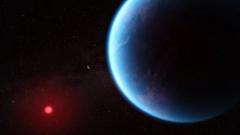The findings indicate a higher concentration of certain gases than found on Earth, although further studies are required to confirm their origins and the planet's capacity to support life.
On September 27, 2023, scientists from Cambridge University presented thrilling yet tentative evidence of possible life on K2-18b, a planet located approximately 700 trillion miles away from Earth. Using the James Webb Space Telescope (JWST), the researchers detected potentially life-indicative molecules in K2-18b’s atmosphere, specifically dimethyl sulphide (DMS) and dimethyl disulphide (DMDS), which are typically produced by marine phytoplankton and bacteria on Earth.
The study's lead, Professor Nikku Madhusudhan, expressed optimism about the findings, stating that the concentrations observed are thousands of times higher than those on Earth. He candidly mentioned that if these gases are indeed linked to biological processes, it would suggest that K2-18b is likely teeming with life. "This is the strongest evidence yet there is possibly life out there," he asserted, hoping to confirm the results in the next year or two.
However, the academic community is cautious; the findings only meet the "three sigma" threshold of certainty (99.7%), falling short of the five sigma (99.99999%) required for definitive claims. As highlighted by independent astronomer Professor Catherine Heymans, even achieving five sigma wouldn’t guarantee that the gases' origins are biological, given the potential for alternative geological explanations.
While the Cambridge research team investigates whether DMS and DMDS could form through non-biological processes, alternative theories about K2-18b's nature persist. Some scientists have proposed that it might possess a large liquid ocean beneath a gaseous atmosphere or even be a mini gas giant lacking a usable surface. Such debates underscore the uncertainty around K2-18b's potential for sustaining life, with various interpretations of JWST data presenting challenges.
Dr. Nicolas Wogan from NASA's Ames Research Center noted the complexities involved in interpreting the faint signals gathered from distant exoplanets. With ongoing research, the Cambridge team remains hopeful about their findings, viewing this moment as a potential historical turning point in humanity's quest to determine our place in the universe.
The groundbreaking research has been formally published in The Astrophysical Journal Letters, contributing to the ongoing discourse on extraterrestrial life and planetary habitability.
On September 27, 2023, scientists from Cambridge University presented thrilling yet tentative evidence of possible life on K2-18b, a planet located approximately 700 trillion miles away from Earth. Using the James Webb Space Telescope (JWST), the researchers detected potentially life-indicative molecules in K2-18b’s atmosphere, specifically dimethyl sulphide (DMS) and dimethyl disulphide (DMDS), which are typically produced by marine phytoplankton and bacteria on Earth.
The study's lead, Professor Nikku Madhusudhan, expressed optimism about the findings, stating that the concentrations observed are thousands of times higher than those on Earth. He candidly mentioned that if these gases are indeed linked to biological processes, it would suggest that K2-18b is likely teeming with life. "This is the strongest evidence yet there is possibly life out there," he asserted, hoping to confirm the results in the next year or two.
However, the academic community is cautious; the findings only meet the "three sigma" threshold of certainty (99.7%), falling short of the five sigma (99.99999%) required for definitive claims. As highlighted by independent astronomer Professor Catherine Heymans, even achieving five sigma wouldn’t guarantee that the gases' origins are biological, given the potential for alternative geological explanations.
While the Cambridge research team investigates whether DMS and DMDS could form through non-biological processes, alternative theories about K2-18b's nature persist. Some scientists have proposed that it might possess a large liquid ocean beneath a gaseous atmosphere or even be a mini gas giant lacking a usable surface. Such debates underscore the uncertainty around K2-18b's potential for sustaining life, with various interpretations of JWST data presenting challenges.
Dr. Nicolas Wogan from NASA's Ames Research Center noted the complexities involved in interpreting the faint signals gathered from distant exoplanets. With ongoing research, the Cambridge team remains hopeful about their findings, viewing this moment as a potential historical turning point in humanity's quest to determine our place in the universe.
The groundbreaking research has been formally published in The Astrophysical Journal Letters, contributing to the ongoing discourse on extraterrestrial life and planetary habitability.








